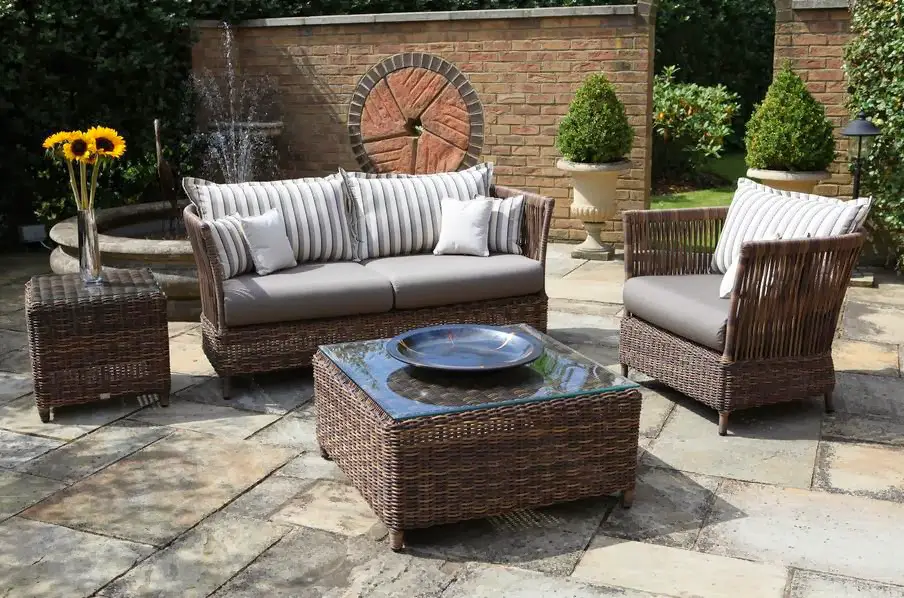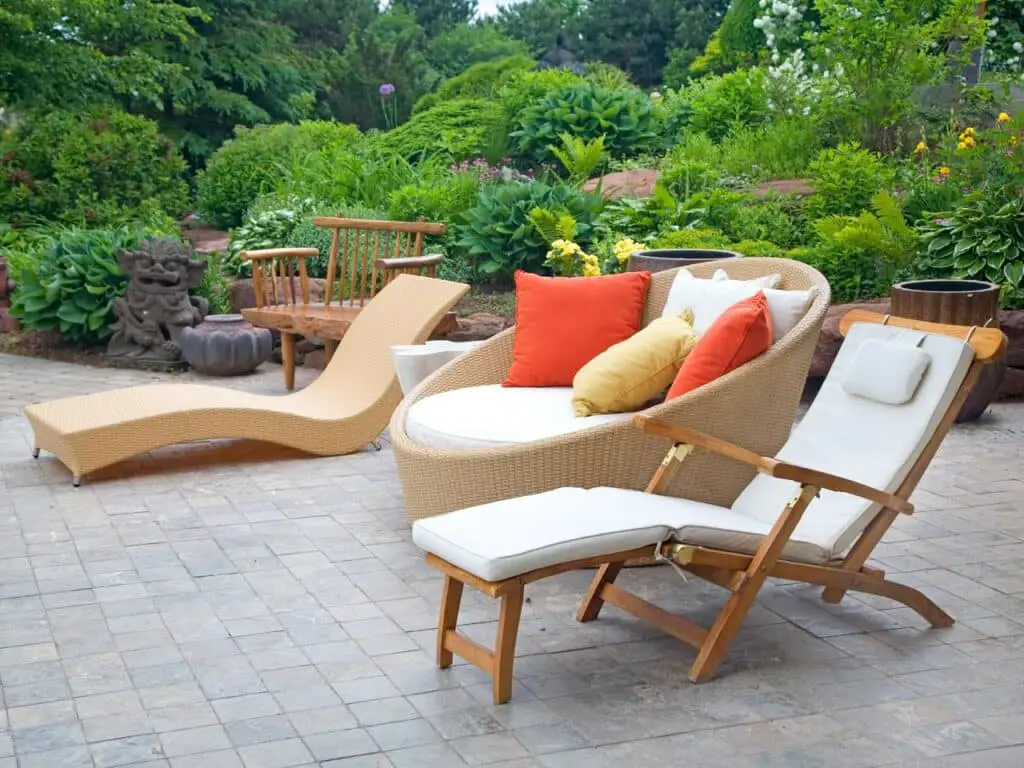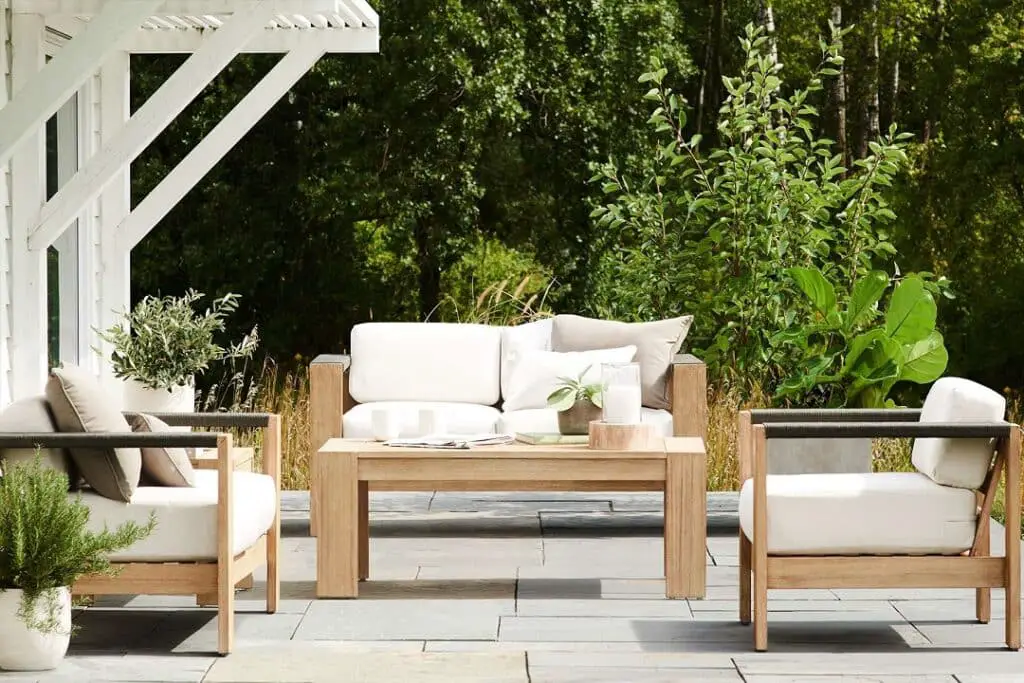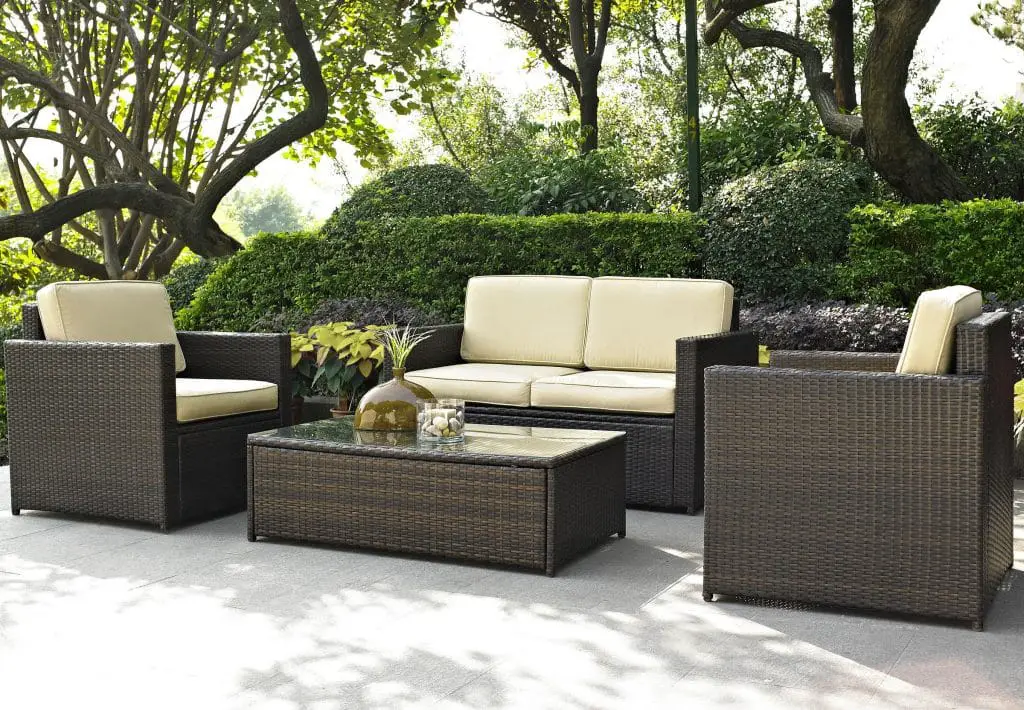How To Refinish Metal Patio Furniture
Introduction
How To Refinish Metal Patio Furniture: Refinishing metal patio furniture is a fantastic way to unleash your creativity and add a personal touch to your outdoor space. Whether you prefer a rustic, vintage look or a sleek, modern design, the refinishing process allows you to tailor your furniture to match your style and preferences. Additionally, we’ll provide tips for maintaining your refurbished furniture to ensure it stands the test of time against varying weather conditions.
Before you begin, it’s essential to understand that refinishing metal patio furniture requires some preparation and patience. Each piece may have its own unique challenges, such as rust, peeling paint, or dents, but with the right approach, you can overcome these hurdles and achieve outstanding patio umbrella results. Techniques for removing old paint or rust, selecting suitable paints and finishes, and properly applying them for a smooth and durable surface.
Not only is refinishing metal patio furniture a budget-friendly alternative to buying new pieces, but it’s also an environmentally conscious decision, as you’ll be giving a second life to existing materials. Plus, the sense of accomplishment and pride in seeing your rejuvenated furniture shine in your backyard is immeasurable.

How do you strip and refinish metal furniture?
How to Paint Rusty Metal Furniture
- Remove Loose Rust. Examine each furniture piece to determine any rusted areas that need attention.
- Sand Rusty Areas. Use a sanding block ($6, The Home Depot) to remove rust down to the bare metal.
- Spray on Primer.
- Apply Spray Paint.
- Finish with Sealer.
Preparation: Start by preparing your work area. Place the furniture on the drop cloth or plastic sheets and ensure good ventilation if you are working indoors. Put on your safety gear to protect yourself during the process.
Assessment: Examine the furniture to identify areas with chipped paint, rust, or other imperfections that need attention during refinishing.
Stripping the old finish: Apply the chemical paint stripper according to the manufacturer’s instructions. Typically, you’ll brush it on and let it sit for a specified time to soften the old finish. Use a scraper or wire brush to gently remove the softened paint and grime. Repeat this process until the majority of the old finish is gone. If dealing with intricate designs, a toothbrush can be useful for getting into crevices.
Rust removal: If your furniture has rust, use a wire brush or sandpaper to remove it completely. Sand the rusted areas until you reach smooth, bare metal. Rust can undermine the new finish if not adequately addressed.
Sanding: After stripping and rust removal, sand the entire surface of the furniture to create a smooth, even texture. Start with a coarse grit sandpaper (around 80) to remove any remaining paint or rough spots, then progress to finer grits (120 and 220) for a polished finish.
How do you strip outdoor metal furniture?
If you want a perfectly smooth finish, hire someone to sandblast your patio furniture, or use paint stripper to remove all the paint. Otherwise, just use a wire brush to remove any loose paint. Then, follow up with 80-100 grit sandpaper. I recommend using a palm sander (and a dust mask) to speed up the process.
Safety gear: Safety goggles, gloves, and a dust mask are essential to protect yourself during the stripping process.
Drop cloths or plastic sheets: Cover your work area to prevent paint or chemical spills from damaging surfaces.
Paint stripper: Choose a chemical paint stripper specifically formulated for metal surfaces. Ensure it is suitable for outdoor use and can handle any existing finishes or paints.
Scrapers and wire brushes: These will help remove old paint, rust, and stubborn grime effectively.
Sandpaper and sanding blocks: Opt for various grits, such as 80, 120, and 220, to smooth the metal’s surface after stripping.
Cleaners and degreasers: Use these to remove any residual paint or stripper residue and to clean the metal thoroughly.
What is the best sandpaper for metal outdoor furniture?
If there is peeling paint or rust you want to remove and you opt to sand your metal furniture to smooth the surface, use medium 180- to 220-grit sandpaper and a sanding sponge for non-ferrous metal (aluminum), or coarse 80-grit sandpaper to sand paint off ferrous metal like wrought iron or steel.
Silicon carbide sandpaper is another excellent option for refinishing metal outdoor furniture. It is particularly effective for sanding harder metals like steel and stainless steel. Silicon carbide abrasives are sharp and hard, making them well-suited for heavy-duty tasks. The grit range for silicon carbide sandpaper is similar to aluminum oxide, ranging from around 80 to 220. Start with coarser grits to remove paint and rust, then progress to finer grits for a polished surface.
Emery cloth is a specialized sandpaper made from emery grains embedded in cloth backing. It is well-suited for metal surfaces and is often used in metalworking applications. Emery cloth is slightly flexible, making it an excellent choice for sanding curved or irregular surfaces on outdoor metal furniture. It comes in different grits, with coarser grits suitable for initial paint and rust removal, while finer grits work well for smoothing and prepping the metal surface.
Metal outdoor furniture, choosing the right sandpaper is essential for achieving a successful and professional-looking result. Aluminum oxide, silicon carbide, and emery cloth are all excellent choices, each with its advantages for different metal types and sanding requirements. By following proper sanding techniques and using the appropriate sandpaper grits, you can prepare your metal furniture surface for painting or sealing.
How do you clean and shine metal patio furniture?
In most cases, metal patio furniture will easily return to “like new” condition by using a sponge or brush to clean surfaces with a quarter cup of mild dish soap added to a gallon of warm water. The greatest enemy of metal furniture is rust.
Remove Debris: Begin by removing any loose debris, leaves, or dirt from the surface of your metal patio furniture. Use a soft cloth or brush to gently sweep away the dirt.
Prepare Cleaning Solution: Mix a few drops of mild dish soap or metal cleaner with warm water in a bucket. Avoid using harsh chemicals that could damage the metal’s finish.
Clean the Furniture: Dip a soft cloth or sponge into the cleaning solution and wipe down the entire surface of the metal furniture. For intricate designs or crevices, use a toothbrush or soft-bristled brush to get into hard-to-reach areas. Ensure that you clean all sides of the furniture thoroughly.
Tackle Stubborn Stains: For particularly stubborn stains or mineral deposits, dampen a cloth with white vinegar or lemon juice and gently rub the affected areas. For tough grime, make a paste with baking soda and water, apply it to the stain, and let it sit for a few minutes before scrubbing it away.
Rinse Thoroughly: After cleaning, rinse the furniture with clean water to remove any soap or cleaning residue. This step is especially important for metal furniture with intricate designs or mesh surfaces.

How do you remove rust and paint from metal furniture?
Process
- Prepare a baking soda & water paste for moderate rust levels.
- Use hydrogen peroxide instead of water for hard rust.
- Apply the thick paste to the affected surface.
- Allow the paste to sit for not more than 20 minutes.
- Scrub the area with an abrasive scrubber like sandpaper or bristle brush.
Preparation: Set up your work area in a well-ventilated space. Lay down drop cloths or plastic sheets to protect surfaces.
Safety First: Put on your safety goggles, gloves, and dust mask to protect yourself from debris and fumes.
Assess the Furniture: Examine the metal furniture to identify areas with rust and peeling paint that need attention.
Rust Removal: Use wire brushes, scrapers, or sandpaper to remove the rust from the metal surface. For heavy rust, you can apply a rust converter or remover following the product’s instructions. Sand the rusted areas until the metal is smooth and rust-free.
Paint Removal: Apply a chemical paint stripper to the painted areas according to the manufacturer’s instructions. Let it sit for the recommended time to soften the paint. Use a scraper or wire brush to gently remove the softened paint. Repeat as needed until the paint is gone.
Sanding: Once the paint and rust are removed, use sandpaper and sanding blocks to smooth the metal surface. Start with a coarse grit (around 80) to remove any remaining paint or rough spots. Progress to finer grits (e.g., 120, 220) for a smoother finish. Sand in one direction for a consistent result.
How do you remove rust from metal patio furniture?
Use white vinegar
Fill a spray bottle with white vinegar and add a pinch of salt to increase the acidity level. Spray it on the affected area and allow it to sit for about 15 minutes, then gently scrub off with a wire brush or piece of steel wool.
Rust Removal: Use wire brushes, scrapers, or sandpaper to remove the rust from the metal surface. If the rust is extensive, you can apply a rust converter or remover following the product’s instructions. Gently scrub the rusted areas until the metal is smooth and rust-free.
Sanding: Once the majority of the rust is removed, use sandpaper and sanding blocks to smooth the metal surface. Start with a coarse grit (around 80) to eliminate any remaining rust or rough spots. Progress to finer grits (e.g., 120, 220) for a smoother finish.
Cleaning: Thoroughly clean the metal patio furniture to remove any debris, rust particles, or dust. Use a cleaner or degreaser to ensure the surface is entirely clean before proceeding.
Rinse: Rinse the furniture with water from a hose or pressure washer to remove any remaining debris or cleaning agents.
Drying: Allow the metal patio furniture to dry completely before moving on to the next steps.
How do you remove oxidation from metal furniture?
Cleaning
- Rinse the furniture and dust with baking soda. Leave for an hour, the scour with steel wool or a metal brush.
- Soak your furniture in vinegar overnight, scrape with steel wool or metal brush.
- Use salt and lemon, dust over the affected area and squeeze lemon over it. Leave for a couple of hours then scrub off.
Assess the Furniture: Examine the metal furniture to identify areas with oxidation that need attention.
Create Cleaning Solution: Mix mild dish soap with warm water in a bucket to create a gentle cleaning solution.
Wipe Down the Furniture: Dip a soft cloth into the cleaning solution and gently wipe down the entire surface of the metal furniture. Ensure you clean all sides and hard-to-reach areas.
Use Vinegar or Lemon Juice: For stubborn oxidation, dampen a soft cloth with white vinegar or lemon juice and gently rub the affected areas. The natural acids in vinegar and lemon juice can help dissolve oxidation.
Scrub with Baking Soda: If needed, make a paste with baking soda and water. Apply the paste to the areas with persistent oxidation and gently scrub with a soft-bristled brush or toothbrush.
Rinse Thoroughly: After cleaning, rinse the furniture with clean water to remove any cleaning residue and oxidation particles.
Dry the Furniture: Use a clean, dry cloth to wipe the furniture and ensure it is completely dry.
What is the best paint to use on metal patio furniture?
My top pick for outdoor spray paint for metal is Rust-oleum Paint+Primer. This metal spray paint has great rust protection that will hold up year round. I have used this in many different sheens (i.e., matte, gloss, satin finish).
Rust-Oleum is a trusted brand known for its high-quality paints, and their Stops Rust Protective Enamel is an excellent choice for metal patio furniture. This oil-based paint provides superior rust protection, adheres well to metal surfaces, and offers a durable, glossy finish. It is available in various colors, allowing you to find the perfect shade to complement your outdoor space.
Krylon Fusion All-In-One is a popular choice for painting metal patio furniture, especially if you prefer the convenience of spray paint. This paint is specially formulated to bond to difficult surfaces like plastic and metal without the need for a primer. It offers excellent adhesion, UV resistance, and comes in a range of colors and finishes.
If you’re looking for a versatile option that works on both metal and other exterior surfaces, consider the BEHR Premium Plus Ultra Exterior Paint and Primer in One. This water-based paint is self-priming, which saves time and effort. It offers excellent coverage, color retention, and weather resistance, making it a reliable choice for metal patio furniture.
Valspar Anti-Rust Armor is designed specifically for metal surfaces, providing protection against rust and corrosion. This oil-based paint dries to a durable, long-lasting finish that can withstand the rigors of outdoor use. It comes in a wide array of colors, allowing you to personalize your furniture to match your outdoor decor.

Conclusion
The furniture, strip off old finishes, sand away imperfections, apply quality paint and protective coatings, and restore the pieces to their former glory. The dedication and effort you put into this DIY project have undoubtedly paid off, leaving you with furniture that not only looks fantastic but also promises to withstand the elements and serve you for years to come. Beyond the tangible results, the experience of refinishing metal patio furniture has likely sparked a newfound passion for creative endeavors and craftsmanship.
You’ve uncovered the joy of transforming ordinary objects into extraordinary pieces that reflect your personality and enhance your living spaces. As you enjoy your revitalized patio furniture, don’t forget to maintain it properly to preserve its beauty and longevity. Regular cleaning, touch-ups, and occasional protective coatings will help protect your investment and keep your outdoor oasis looking stunning throughout the seasons.
Remember, the possibilities for refinishing metal patio furniture are limitless, so don’t be afraid to experiment with different colors, textures, or styles in the future. As you gain more confidence and expertise, you might even consider taking on more ambitious projects, refurbishing other metal items throughout your home. Now that you’ve successfully completed this rewarding DIY journey, take a moment to appreciate your hard work and the transformative power of a little ingenuity. Your beautifully refinished metal patio furniture stands as a testament to your creativity and determination.








